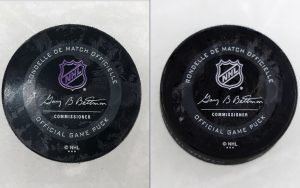- Slug: Sports-NHL Puck Color, about 600 words.
- Photos available
By Alex Simon
Cronkite News
GLENDALE – A puck that changes colors? Welcome to the latest technological advancement with the National Hockey League’s rubber disk.
For the 2019-20 season, game pucks will come with a thermochromic coating that is purple when frozen, but turns clear as the pucks thaw above freezing temperatures. That change should make it easier for officials to identify when the pucks on the ice should be replaced.
Warmer pucks tend to bounce more and are more difficult to control. Frozen ones glide smoother and faster. In the modern NHL, an average game will use about a dozen pucks.
“I think they have 20-25 pucks inside the penalty box there and after everyTV timeout and every goalie stop they change them out,” Arizona Coyotes forward Christian Fischer said.
The color change is most obvious on the wording of the puck as it starts to warm up.
“There is a range. The league likes it between about 14 and 20 (degrees) with 18 being preferred temperature,” said Patrick Schuler, manager of ice operations at Gila River Arena, where the Arizona Coyotes play.
The change is part of a three-year deal between the NHL and PPG, a paint supplier based in Pittsburgh that developed the coating with the help of LCR Hallcrest and QCR Solutions. After testing it in the 2019 Winter Classic, the league felt ready to debut the innovation across the continent.
“We are excited to extend our partnership with PPG, a leader in the paint industry and committed NHL partner that activates across many levels of our game,” NHL Group Vice President of Partnership Marketing Evin Dobson said. “Integrating thermochromic coating pucks in all NHL games is a testament to PPG, LCR and QCR’s innovative technology.”
The implementation is in line with the league’s continued push to remain on the front end of technological innovation. The league plans to deploy a puck-and-player tracking system this season, with RFID tags in the puck and on players’ pads to follow them. It’s been tested a few times, including during two Vegas Golden Knights games in January.
The NHL has experimented with its puck before. When Fox Sports owned the television rights to the 1996 NHL All-Star Game, it introduced the “glowing puck,” which used infrared technology to follow LED lights inside the puck to create a so-called comet tail on the puck that helped track it on television.
While the system, officially known as FoxTrax, only lasted two years and was considered “one of the worst ideas in sports” at the time, it is regaining popularity. ESPN writer Greg Wyshynski recently advocated for the glow puck to return.
The idea for the thermochromic coating follows a recent pattern most often seen in the beer industry. Coors Light famously created labels on which the mountains turn blue when the beer is at the perfect temperature. While that label changed in the 40º to 44º F range, the NHL’s pucks will change colors once the puck’s temperature rises above freezing.
“Hockey pucks are made of vulcanized rubber and glide smoother and faster when frozen,” NHL Vice President of Facilities Operations Dan Craig said ahead of its trial run at the 2019 Winter Classic. “Freezing a puck eliminates bouncing, and game officials monitor the puck for temperature changes that affect performance while in play. A coating that changes color when the puck is above freezing will more accurately alert the officials that it is time for a replacement.”
Nick White contributed to this report.
For more stories from Cronkite News, visit cronkitenews.azpbs.org.
